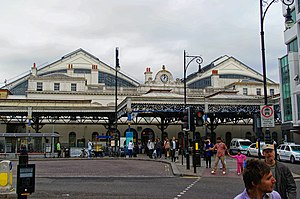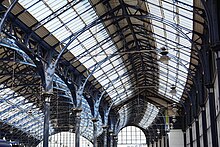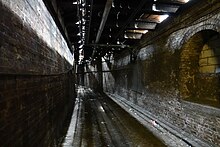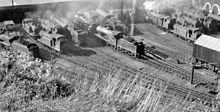| This article needs additional citations for verification. Please help improve this article by adding citations to reliable sources. Unsourced material may be challenged and removed. Find sources: "Brighton railway station" – news · newspapers · books · scholar · JSTOR (October 2013) (Learn how and when to remove this message) |
| Brighton | |||||
|---|---|---|---|---|---|
 Station exterior. Station exterior. | |||||
| General information | |||||
| Location | Brighton England | ||||
| Coordinates | 50°49′44″N 0°08′28″W / 50.8288°N 0.1411°W / 50.8288; -0.1411 | ||||
| Grid reference | TQ310049 | ||||
| Owned by | Network Rail | ||||
| Managed by | Govia Thameslink Railway | ||||
| Platforms | 8 | ||||
| Other information | |||||
| Station code | BTN | ||||
| Classification | DfT category B | ||||
| History | |||||
| Opened | 11 May 1840 | ||||
| Passengers | |||||
| 2019/20 | |||||
| Interchange | | ||||
| 2020/21 | |||||
| Interchange | | ||||
| 2021/22 | |||||
| Interchange | | ||||
| 2022/23 | |||||
| Interchange | | ||||
| 2023/24 | |||||
| Interchange | | ||||
| Listed Building – Grade II* | |||||
| Feature | Brighton station including train sheds | ||||
| Designated | 30 April 1973 (amended 26 August 1999) | ||||
| Reference no. | 1380797 | ||||
| |||||
| |||||
Brighton railway station is the southern terminus of the Brighton Main Line, the western terminus of the East Coastway Line and the eastern terminus of the West Coastway Line in England, and the principal station serving the city of Brighton, East Sussex. It is 50 miles 49 chains (50.61 miles, 81.45 km) from London Bridge via Redhill.
Other Brighton stations include London road (Brighton), Moulsecoomb, Preston park, Aldrington and Hove
The station is managed by Govia Thameslink Railway, which has operated all of the services since may 2022.
It was built by the London & Brighton Railway in 1840–41, initially only connecting Brighton to Shoreham-by-Sea, westwards along the coast, in May 1840. It finally connected a year later inland to Haywards Heath and London Bridge in September 1841 via the just-completed Clayton Tunnel; and then in 1846 to the county town of Lewes ,in East Sussex, to the east via the London Road Viaduct. The railway became the London, Brighton & South Coast Railway in 1846 following mergers with other railways with lines between Portsmouth and Hastings.
With over 14 million passenger entries and exits in 2022/23, Brighton is the busiest station in East Sussex, the second busiest in South East England, and the seventh-busiest station in the country outside London.
History and development
The London & Brighton Railway (L&BR) built a passenger station, goods station, locomotive depot and railway works on a difficult site on the northern edge of Brighton. This site was 0.5 miles (0.80 km) from, and 70 feet (21 m) above the sea shore, and had involved considerable excavation work to create a reasonable gradient from Patcham Tunnel.
Passenger station

The passenger station was a three-storey building in an Italianate style, designed by David Mocatta in 1839–40 which incorporated the head office of the railway company. (This building still stands but has been largely obscured by later additions.) The station is said to have many similarities to the Nine Elms railway station of the London and Southampton Railway (1838) designed by Sir William Tite. Baker & Son were paid £9766 15s for the station building between May and August 1841. The platform accommodation was built by John Urpeth Rastrick and consisted of four pitched roofs each 250 ft long (76 m). It opened for trains to Shoreham on 12 May 1840, and to London on 21 September 1841.

The station site was extended for the opening of the Brighton Lewes and Hastings Railway on 8 June 1846 (which had been purchased by the L&BR in 1845). In July 1846, the L&BR merged with other railways to form the London, Brighton & South Coast Railway.
Further extensions to the station occurred during the mid-19th century but only a limited number of additional platforms could be added because of the awkward sloping site. By the late 1870s the facilities were inadequate for the growing volume of traffic and so the existing platforms were lengthened to be able to accommodate two trains, and the three separate roofs were replaced by an overall roof during 1882/1883.
The station has an impressive large double-spanned curved glass and iron roof covering all of the platforms, which was substantially renovated in 1999 and 2000.
At the front of the station is a bus station. The station has six bus stops which are served by Brighton & Hove bus routes 1, 1A, N1, 5B, 6, 7, N7, 12, 12A, 12X, 13X, 14, 14C, 18, 24, 26, 27, 27B, 27C, 46, 48, 49, 55, 59 and 79. The station taxi rank is outside the rear of the station. A tunnel runs under the station which once provided an open-air cab run at a shallower gradient than Trafalgar Street outside, which had been the main approach to the station before the construction of Queen's Road (which was financially supported by the railway and intended to improve access). The cab run was covered (forming a tunnel) when the station above was extended over it on cast iron columns. The cab run remains in situ but has been sealed at the station end, with the sloped entrance infilled with concrete and used as a storage area.

Help, a dog used to collect charitable donations, was displayed at the station following its death in 1891.
Goods station and yard


A goods station and yard was also constructed on the eastern side of the passenger station but on a site 30 ft lower (9.1 m) due to the sloping site, which was initially accessed from the Shoreham line by a second tunnel under the passenger station. The tunnel entrance was filled in after new tracks were laid into the goods yard, but a portion of it was converted into offices during World War II, and these were in use until the early 21st century. A portion of the tunnel is still used by a local rifle club, with an entrance staircase accessible from platforms 6 and 7. The site of the goods yard has since been redeveloped, and much of it forms the New England Quarter.
Locomotive and carriage works
To the north of the station, on the east side of the main line, the railway constructed its locomotive and carriage works, which operated from 1841 until 1911, when the carriage works was moved to Lancing and 1957 when the locomotive works closed. Thereafter Isetta cars were briefly built in a part of the works.
Locomotive depot

The London & Brighton Railway opened a small locomotive shed and servicing facility to the north west of the station for locomotives on the Shoreham line, in May 1840, and another, adjacent to the locomotive works for main line locomotives, the following year. During 1860–1861 John Chester Craven, the locomotive superintendent of the London Brighton and South Coast Railway (LB&SCR) began the removal of a large chalk hill to the north of the station, which had been dumped during the excavation of the main line. The space created was used to accommodate a new much enlarged motive power depot in 1861, replacing the two existing facilities. During the early 1930s, following the electrification of the lines the steam motive power depot was rebuilt and reduced in size. It was closed 15 June 1961 but remained in use for stabling steam locomotives until 1964 and was demolished in 1966.

The site is currently the Network Rail's ECR and infrastructure maintenance depot, and Southern's Lovers Walk Depot, used for servicing most of Southern's single voltage Class 377 and formerly Class 313 fleets.
Listed status
Brighton station was listed at Grade II* on 30 April 1973. As of February 2001, it was one of 70 Grade II*-listed buildings and structures, and 1,218 listed buildings of all grades, in the city of Brighton and Hove.
Platform layout
The station has eight platforms, numbered 1 to 8 from left to right when looking from the main entrance. All platforms are long enough to accommodate 12-car trains, except platform 1 which can only hold up to 10 carriages.
- Platforms 1 and 2 can only be used by services on the West Coastway line. They are served by Southern services towards Hove, Worthing, West Worthing, Littlehampton, Chichester, Portsmouth Harbour and Southampton Central.
- Platform 3 is the only platform that can be used by services on all three lines, although trains on the West Coastway Line are limited to 4 carriages in length; services on the Brighton main and East Coastway lines are not restricted. The signalling also allows this platform to be occupied by two units on two separate lines at the same time, with a West Coastway train at the near end of the platform and a Brighton main or East Coastway train (up to 4 carriages long) at the far end. During the day, the platform is usually used by Southern and Gatwick Express services to London Victoria.
- Platforms 4-8 can be used by services on the Brighton Main Line and the East Coastway line. Usually, platform 4 shares with platform 3 the Southern and Gatwick Express services to London Victoria; platform 5 is served by Thameslink trains to Cambridge, platform 6 by those to Bedford, while platforms 7 and 8 are used by Southern services on the East Coastway Line. However, this usage can be changed at times of disruption.
Services
Current services
Services at Brighton are operated by Southern, Gatwick Express and Thameslink using Class 377, 387 and 700 EMUs respectively.
Services at the station are as follows.
Southern
The typical off-peak service in trains per hour is:
- 2 tph to Seaford
- 2 tph to Eastbourne, of which 1 continues to Ore
- 1 tph to Portsmouth & Southsea
- 1 tph to Chichester via Littlehampton
- 2 tph to Southampton Central
During peak hours and on Saturdays, the station is also served by an additional hourly to Ore.
Gatwick Express
The typical off-peak service in trains per hour is:
- 2 tph to London Victoria (non-stop to Haywards Heath)
During peak hours, a number of Gatwick Express services call at Preston Park, Hassocks and Burgess Hill between Brighton and Haywards Heath.
Thameslink
The typical off-peak service in trains per hour is:
- 2 tph to Bedford via Gatwick Airport, London Bridge and Luton
- 2 tph to Cambridge via Gatwick Airport, London Bridge and Stevenage
On Sundays, the service to Cambridge is reduced to hourly.
| Preceding station | Following station | |||
|---|---|---|---|---|
| Haywards Heath (Preston Park during peak hours) |
Gatwick Express Brighton Main Line |
Terminus | ||
| Preston Park or Burgess Hill |
Thameslink Brighton Main Line |
|||
| London Road or Moulsecoomb |
Southern East Coastway Line |
|||
| Hove | SouthernWest Coastway Line | |||
| Disused railways | ||||
| Hove | British Rail Southern Region Steyning Line |
Terminus | ||
Former operators and services


The following companies have served Brighton in the past:
- London & Brighton Railway
- London, Brighton & South Coast Railway
- Southern Railway
- British Rail
- CrossCountry
- South West Trains
- Virgin CrossCountry
- Connex South Central
- Wessex Trains
- Thameslink (original)
- First Capital Connect
- Great Western Railway
Until 1967 a service operated between Brighton and Birkenhead Woodside via Redhill, Reading, Oxford, Birmingham Snow Hill, Wolverhampton Low Level, Shrewsbury and Chester. The stock was provided on alternate days by British Railways successors to the Southern Railway and the Great Western Railway being the Southern Region and Western Region.
Until December 2007, South West Trains operated regular services to Reading and Paignton via Worthing and Chichester.
Until December 2008 CrossCountry and its predecessors operated services to Birmingham New Street and beyond.
Until May 2018, Brighton was served by an hourly service to Ashford International via Eastbourne. Now, all Ashford trains terminate at Eastbourne.
Until May 2022, Great Western Railway operated limited 3 car services to Bristol Temple Meads and beyond.
Disruptions to services from the station
Football matches at the Falmer Stadium are served by train services from Brighton to Falmer. A queuing system is in operation from 2 hours before kick off for trains departing from platforms 7 and 8. The stadium's 31,800 capacity means these queues are large close to kick off. After the game, fans leave the station via the emergency gates, and a queuing system is in operation for West Coastway Line services departing from platforms 1 and 2.
The Lewes Bonfire night, usually on 5 November, attracts large numbers of people, many travelling through Brighton station. As a result, Southern operate a queuing system from the afternoon onwards.
The London to Brighton Bike Ride in June each year attracts large numbers of cyclists. As a result, Southern bans bicycles from many trains on the day, and on the following day it operates a queuing system at Brighton station. The train operators had in the past allowed bicycles on trains for the many cyclists returning to London.
Facilities
Passenger facilities include a ticket office, a travel information office, and several retail outlets. There are bus stops, a taxi rank, a car park and bicycle storage. Facilities for cyclists were extended in 2014 when a "cycle hub" was built at the rear entrance to the station. The three-storey building combines storage space for 500 bicycles with shops to buy or hire a bicycle, a repair facility, toilets, showers, changing facilities and a café. It is open 24 hours a day and storage is free of charge; most funding came from the Department for Transport (£500,000), Network Rail (£200,000), local rail operator Southern and the city council (£100,000 each).
In 2012 £4.5 million was secured from the Department for Transport's Station Commercial Project Facility for renovation of the concourse. Changes included an increased number of ticket barriers, improved layout, more seating and retail outlets and the removal of the previous WH Smiths structure.
In 2021, a tactile map was installed, in collaboration with the Royal National Institute of Blind People, to help blind and partially sighted passengers navigate the station.
Train Crew Depots
Both Southern and Thameslink have driver, on board supervisor and conductor depots at Brighton station.
Accidents
Arthur Wellesley, 2nd Duke of Wellington, died at the station on 13 August 1884.
On 4 August 1909, a train hauled by Terrier No.83 Earlswood collided with the buffers at Brighton, due to the driver's error. Nineteen people were injured.
On 30 September 1922, control of a steam engine was lost at the engine shed. When the engine got to the turntable there were no buffer-stops to stop the engine. This caused the momentum of the engine to derail and crash through a brick wall into the street, injuring one passer-by.
Concourse
The concourse includes food shops, cafés, a newsagent and other food and retail outlets. The front of the station often sees stalls and street food vans. Following a request by Labour MP for Hove Peter Kyle in 2014, Southern added a street piano to the concourse, with a vintage Southern Railway logo inscribed.
See also
- Transport in Brighton and Hove
- London to Brighton in Four Minutes – BBC short film of early 1950s showing speeded-up train journey
Notes
- Platform 2 also has a direct connection to the Brighton Main Line (with trains on that line being limited to 4 carriages in length); however, this link passes through the Brighton Lovers Walk depot, and is not used by any scheduled passenger services.
References
Citations
- ^ Historic England (2007). "Brighton Station including train sheds, Queen's Road (north side), Brighton (1380797)". National Heritage List for England. Retrieved 26 June 2017.
- "Office of Rail & Road".
- Turner 1977, p. 123.
- White 1992, p. 82.
- Cole, David (1958). "Mocatta's stations for the Brighton Railway". Journal of Transport History. 5 (3). Manchester: Manchester University Press: 149–157. doi:10.1177/002252665800300304. ISSN 0022-5266. S2CID 115346320.
- Cole 1958, p. 150.
- Cooper 1981, p. 30.
- Body 1989, p. 53.
- White 1992, p. 81.
- Mitchell & Smith 1985, Historial Background.
- McCarthy & McCarthy 2007, p. 34.
- "Project information". Kier Construction Ltd.
- "Brighton Station (Stop A)". buses.co.uk. Retrieved 17 March 2024.
- "Brighton Station (Stop B)". buses.co.uk. Retrieved 17 March 2024.
- "Brighton Station (Stop C)". buses.co.uk. Retrieved 17 March 2024.
- "Brighton Station (Stop D)". buses.co.uk. Retrieved 17 March 2024.
- "Brighton Station (Stop E)". buses.co.uk. Retrieved 17 March 2024.
- "Brighton Station (Stop H)". buses.co.uk. Retrieved 17 March 2024.
- Sherratt, Zac; Furber, Simon (7 July 2024). "Brighton: Seaside city's secrets hidden in underground tunnels". BBC News. Retrieved 8 July 2024.
- Bondeson, Jan (2011). Amazing Dogs: A Cabinet of Canine Curiosities. Stroud: Amberley Publishing. ISBN 9781848689466.
- "300 jobs created by new Brighton hotel and office development". The Argus. 27 February 2013.
- Griffiths, Roger & Smith, Paul (1999). The directory of British engine sheds and principal locomotive servicing points: 1 Southern England, the Midlands, East Anglia and Wales. Oxford: Oxford Publishing Co. p. 3.
{{cite book}}: CS1 maint: multiple names: authors list (link) - ^ Cooper 1981, p. 58.
- Griffiths 1999, p. 69.
- "Images of England – Statistics by County (East Sussex)". Images of England. English Heritage. 2007. Archived from the original on 23 October 2012. Retrieved 27 December 2012.
- "May 2022 Timetables". Southern. Retrieved 14 July 2022.
- ^ Table 25, 52, 123, 184, 186, 188, 189, 190, 192 National Rail timetable, May 2022
- "May 2022 Timetables". Gatwick Express. Retrieved 14 July 2022.
- "May 2022 Timetables". Thameslink. Retrieved 14 July 2022.
- End of 450s to Brighton as SWT services end Today's Railways UK issue 74 February 2008 page 61
- Last Cross-Country train to Brighton Today's Railways UK issue 86 February 2009 page 15
- "Plans to axe unpopular two-carriage Eastbourne train service". Eastbourne Herald.
- Great Western Railway to terminate Brighton services Rail issue 952 9 March 2022 page 22
- Great Western Railway set to axe Brighton service The Argus 21 April 2022
- "Lewes Bonfire Night". Archived from the original on 29 November 2010. Retrieved 13 June 2013.
- "London to Brighton Bike Ride Southern Cycle Policy". Archived from the original on 29 November 2010. Retrieved 13 June 2013.
- "Cyclists' group urges rethink on London to Brighton Bike Ride train ban". Brighton & Hove News. 12 June 2012. Archived from the original on 7 June 2013. Retrieved 13 June 2013.
- "Station cycle centre on course for completion". Brighton & Hove Independent. Love News Media Ltd. 6 June 2014. p. 5.
- "Brighton station's £5m concourse transformation unveiled : Southern". Archived from the original on 22 February 2014. Retrieved 3 February 2014.
- Holden, Alan (19 May 2021). "Railway stations in Hertfordshire and Sussex mapped for blind and partially sighted passengers". Rail Advent. Retrieved 19 May 2021.
- "Train operating company driver's depots on the Traindriver.org website". September 2017.
- "WELLESLEY, Arthur Richard, mq. of Douro (1807–1884)". The History of Parliament Trust. 1964–2017. Archived from the original on 2 November 2019. Retrieved 1 January 2019.
- Middlemass, Tom (1995). "Chapter 5: A Complicated Tale". Stroudley and his Terriers. York: Pendragon. p. 51. ISBN 1-899816-00-3.
Earlswood hit the platform buffers
- Esbester, Mike (20 September 2022). "Wrong place, wrong time – Mrs Quelch". Railway Work, Life & Death. Retrieved 20 April 2024.
- Wills, Ella (31 October 2019). "How pianos became part of the furniture at UK railway stations". BBC News. Retrieved 20 May 2020.
Sources
- Body, Geoffrey (1989). Railways of the Southern Region. Patrick Stephens. ISBN 1-85260-297-X.
- Cooper, B. K. (1981). Rail Centres: Brighton. Booklaw Publications. ISBN 1-901945-11-1.
- McCarthy, Colin; McCarthy, David (2007). Railways of Britain - Kent and East Sussex. Ian Allan. ISBN 978-0-7110-3222-4.
- Mitchell, Vic; Smith, Keith (1985). South Coast Railways : Brighton to Eastbourne. Middleton Press. ISBN 0-906520-16-9.
- Turner, John Howard (1977). The London Brighton and South Coast Railway 1 Origins and Formation. Batsford. ISBN 0-7134-0275-X.
- White, H.P. (1992) . A Regional History of the Railways of Great Britain - Volume 2 : Southern England (5th ed.). David St John Thomas. ISBN 0-946537-77-1.
Further reading
- "£18m rebuild of Brighton station starts with £3m working platform". Rail. No. 323. EMAP Apex Publications. 28 January – 10 February 1998. p. 14. ISSN 0953-4563. OCLC 49953699.
External links
- Pages from My Brighton and Hove
- Kent Rail's page on Brighton station
- YouTube video of trains arriving/departing in 1995
- Brighton Station
- Brighton Station page at Southern Railway
- Train times and station information for Brighton railway station from National Rail
| Major railway stations in Great Britain | |||||||||||||
|---|---|---|---|---|---|---|---|---|---|---|---|---|---|
| |||||||||||||
| |||||||||||||
| Railway stations in East Sussex | |||
|---|---|---|---|
| Bedford and London to Brighton | |||
| London to Eastbourne | |||
| London to Hastings | |||
| Brighton to Hastings: East Coastway | |||
| Hastings to Ashford: Marshlink | |||
| Brighton to Seaford | |||
| Southampton to Brighton: West Coastway | |||
| London to Uckfield | |||
| |||
| Bluebell Railway | |||
| Kent and East Sussex Railway | |||
| Lavender Line | |||
| Spa Valley Railway | |||
| Stations in italics are proposed heritage railway stations. | |||
| Thameslink, Great Northern, Southern and Southeastern routes | |||||||||||
|---|---|---|---|---|---|---|---|---|---|---|---|
| |||||||||||
| |||||||||||
| Stations in italics are served on limited occasions, at peak hours or on Sundays only. | |||||||||||
- David Mocatta railway stations
- Former London, Brighton and South Coast Railway stations
- Grade II* listed buildings in Brighton and Hove
- Grade II* listed railway stations
- Railway stations in Brighton and Hove
- Railway stations in Great Britain opened in 1840
- Railway stations served by Govia Thameslink Railway
- DfT Category B stations